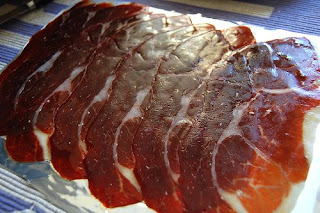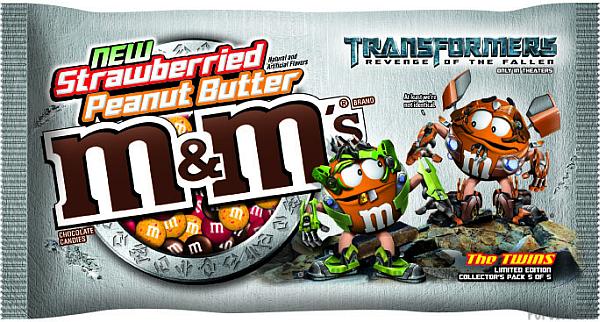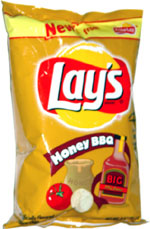Monday, November 9, 2009
Recent candy roundup
Snickers Fudge: I'm not overly taken with Snickers in the first place; their chocolate has an oddly sharp taste, almost acrid, at least to my palate. This might also be the contribution of the peanuts, and so switching to peanut butter nougat in the Fudge variety doesn't really help matters. This might be good for a lark if you like Snickers but wish they were more chocolatey, but you'll probably be disappointed - the fudge is present but at least partially masked by the inferior chocolate coating of the whole bar. On the other hand, if you like that chocolate coating in the first place you can probably make it work.
Bat Dots: Dots have kind of gotten the big head over the last few years. First they released Tropical Dots, which were not very good, and then Yogurt Dots, which were terrible. (Somehow both products remain on the market.) Now they just keep putting out strange seasonal varieties which all seem to have one thing in common: they don't contain a mix of flavors. Would you buy a bag of Skittles that was all reds? What makes Dots good in the first place is the variety; an entire box of black-colored but "blood orange"-flavored Dots is asking too much of the consumer, in my opinion. These taste all right but I just got sick of them after a while, which wouldn't have been as much of a problem with a mixture. How hard could that possibly be? Anyway, you won't likely have to worry about whether or not to pick these up now that Halloween is over, so whatever.
Tropical Chewy Lemonhead and Friends: Has tropical ever not been candy code for "awful"? The problem with these things goes to two sources: one, the flavor mix, and two, the complete lack of tartness. For a product that contains real lemon juice according to the ingredients, there is a stunning absence of even a hint of pucker in this candy, a problem that might be more forgivable if the flavors weren't so utterly mediocre. The lemon/pink lemonade is the most tolerable, and cherry/watermelon can pass, but kiwi/strawberry is forgettable, peach/mango somewhat dire, and I wouldn't touch berry/banana with a ten-foot clown pole. Isn't the whole gimmick of Lemonheads being tart? Aren't regular Chewy Lemonhead and Friends at least mildly tart? Did I just get a reject box? Regardless, I can't be unequivocal enough: do not ever buy these. The regular stuff is a million times better. (The Ferrara Pan website says of these, "You asked for it, you got it!" Ferrara Pan, what did we ever do to you?)
Saturday, July 18, 2009
Jamon it, all right
After confirming that wasn't a misprint, I came home and did a little research. Jamón ibérico, ham from black Iberian pigs from the south of Spain, is the most expensive ham in the world, and the bellota is the cream of the crop. Bellota ham is made from pigs that eat nothing but acorns in southwest Spain's oak forests for the last months of their lives, giving the meat an intense marbling and a nutty taste (at least supposedly). I decided I had to try this ham.
So I went back with a coworker who had the idea to expand the thing to a three-way Spanish ham taste test. We'd start with the "basic" serrano ham (priced to move at a mere $26.99/lb), then move on to the standard ibérico ham (which retails at $89.99/lb), and finish with the bellota.
I had never before had serrano ham in isolation, outside of a sandwich and without the accompaniment of Manchego. The taste was sharp and fairly salty, but pleasant; I found something vaguely woodsy about it. The color of the meat was fairly light, and it could be a little tough to bite through depending on if I was biting the outside of the slice, which was surrounded by a ring of fat that got fairly thick on one end.
Next was the $89.99/lb ibérico. Already I could see a darker, richer color to the meat, and the marbling was noticeable (supposedly the second grade of ibérico, one down from bellota, is finished merely half on acorns and half on grain, so if this was that kind, it certainly makes sense). I tasted some nuttiness, and noted that it seemed lighter and less salty than the serrano (although it was certainly greasier). It tasted rather like a high-end cheese, in fact.
Finally came the pig de résistance. The bellota was perhaps even slightly darker than the regular ibérico, the marbling even more pronounced, the flecks of fat poking up from the paper-thin slices even more noticeable. The paper on which the ham sat peeled away, as the meat practically oozed oil. The tenderness was ridiculous - while the serrano could at times be difficult to chew, the bellota could be pulled into as many pieces as you wanted by hand, and even the biggest attachments of fat simply melted away in the mouth. I almost didn't even need to chew it. Perhaps owing to the 36-month curing process, the bellota seemed saltier again than the ibérico had been, but as I chewed, the saltiness began to fall away, and the ham presented a rich, earthy aftertaste. It seemed that I was tasting both the pig itself and the natural environment in which it had lived.
Unquestionably, the bellota ham was the best. At the same time, it's difficult to argue that it's worth three bucks a slice - yeah - except to say you've tried it. And really, the regular ibérico was up there with it - while it clearly was not as superior, I can't say it was half as good, and since it costs half of what the bellota costs, if you're looking to splurge on a high-end ham, you might as well save yourself a bit of money and stick with the stuff that merely costs 90 bucks a pound (or $1.50 a slice). You have to be willing to eat the ham on its own, though; this stuff is too expensive and too complex to justify putting it with, well, anything really - maybe alternate bites with a piece of Manchego or Mahón or something, but that's about it. If you're just looking for a nice classy ham sandwich, serrano ham will do you just fine.
Friday, July 17, 2009
Rebirth of a blog
So the blog is being repurposed as "Notes from an Omnivore" (I'm open to title suggestions). I'll try almost anything once, and my investigation of new (to me) types of food can now be extended not just into just-on-the-market products but also to cuisines I'm trying for the first time, or even my attempts at cooking. There might still be junk food reviews here, but they're going to be fewer and farther between, and surrounded by a lot more reviews of other stuff. I won't promise constant updates - I don't do that anywhere anymore - but there should be a few more than there have been.
Wednesday, June 3, 2009
Strawberried Peanut Butter M&Ms
Mars apparently has a thing for hooking itself to summer blockbusters these days. Last year there were Mint Crisp M&Ms and the Snickers Adventure Bar, both discussed in the June 16, 2008 podcast, which tied into Indiana Jones and the Kingdom of the Crystal Skull. Not content with one questionable summer sequel, Mars has joined up with the second Michael Bay Transformers movie. They've also continued their trend of adding berry flavors to M&Ms (which have gone one good, one bad for me so far). This time, though, it's strawberries, and the M&Ms in question are actually peanut butter. Presumably the idea is that these two flavors go together in a PB&J (unless you're a grape jelly person), so surely they'll go together in an M&M.
It's an intriguing thought, but things never quite work that way. When you're making a candy product and trying to impersonate something that isn't candy, you usually end up with a curiously ersatz version, and it's really no different here. In isolation, the peanut butter tastes like peanut butter, and I guess the strawberry flavor tastes enough like a real strawberry - but neither tastes quite enough like the real thing for anyone to be fooled by the combination. Not that M&Ms is trying to fool anyone into thinking they're eating a sandwich, of course, but the way peanut butter and strawberry jam might mesh between two slices of bread is not sufficiently aped by the way peanut butter and strawberry flavor mesh here. I had a similar problem with the raspberry M&Ms - I might like eating raspberries covered in chocolate, but taking raspberry flavoring and grafting it onto an M&M just isn't the same experience, and it's never going to be.
And so it is here. I can taste the peanut butter, and I can taste the strawberry, but I never found that the two of them mixed all that well. It probably doesn't help that M&Ms peanut butter is so sweet - not only does the inherent sweetness overwhelm some of the strawberry taste, but without a richer peanut taste, there simply isn't the mix of flavors that might result from a well-made PB&J.
Strawberried Peanut Butter M&Ms are far from the worst things in the world, but their reason to exist is pretty small. Peanut Butter M&Ms don't really need modification, but if they're going to have one, it really needs to be more impactful.
Tuesday, June 2, 2009
Southwestern Ranch Baked Lay's
I saw these for the first time tonight at Subway, so I went for it. If you like Baked Lay's and appreciate a little heat, this is the chip for you. There's a nice, fairly mild heat coming from some cumin and chilies, as well as an appealing hint of cream that gives the flavor some depth. And of course there's the usual advantage of Baked Lay's - they're not greasy, so you have that nice crispy texture and cleaner potato taste.
I know not everyone appreciates Baked Lay's, and obviously spice isn't for everyone either. But for those of us who like both things, this is a really strong snack, and it goes great alongside a sandwich.
Friday, May 22, 2009
Honey Barbecue Lay's Potato Chips
My bag didn't look like this - it has an actual photo of the chips, a sliced potato in the background, and a bowl of honey and barbecue sauce with a basting brush with sauce on it in the foreground. Anyway.
I had high hopes for these chips - you see "Honey Barbecue" and you think tangy, sweet, a little spicy, right? When it came down to it, though, there wasn't much going on. Not only was the barbecue sauce taste fairly ordinary, it was way too heavy on a smoky, mesquite kind of flavor which I just wasn't a huge fan of. Mesquite is fine on its own, I guess, but this isn't a bag of mesquite chips. Something with "honey solids" in it, as listed in the ingredients, should have a honey flavor somewhere; I couldn't find it. The mesquite wore off a bit as I got farther down in the bag, and there was a bit more of a tangy flavor to the chips near the end, but it shouldn't take that long.
More to the point, I guess I just expect more out of Lay's. We're talking the biggest chip brand in the world - if they do a Honey Barbecue chip, shouldn't it really knock that taste out of the park? Instead it was barely even close. For the most part these just tasted like any barbecue potato chips I could have gotten in any bag, with any brand name on the front, in any store in America. They were a genuine disappointment.
Wednesday, May 13, 2009
Pepsi Throwback
Much has been made in recent years of the evils of high fructose corn syrup, with claims made about its more negative health effects than "regular" sugar and a vocal subset of cane sugar fans who insist that sodas made with their standard-bearer just taste better. I don't have any particular interest in getting in the middle of either of those debates (I go back and forth on cane sugar, due to its extremely distinctive taste), but it's interesting to see a company of Pepsi's stature giving some play to the whole debate by releasing "throwback" editions of its two biggest brands, Pepsi and Mountain Dew, to a national audience. There's something about "throwback" which implies that things were better before, and one wonders what Pepsi might do if this new edition proves popular. (At least they learned the lesson of New Coke and didn't try to completely supplant their existing product. As it is I've yet to find Pepsi Throwback outside of grocery stores in the Chicago area; not a convenience store I've been in has carried the stuff.)
Pepsi doesn't specify the provenance of the "natural sugar" found in Throwback. Assuming it's sucrose, sugar cane is the most likely source, but as I said above I usually find cane sugar to have a distinctive "caney" taste, which I didn't notice in Throwback (though cola always does the best job of hiding any distinctiveness in the taste of its sweetener, so it's not out of the question).
Regardless of where the sugar comes from, it does its job. As outlined by Malcolm Gladwell in Blink, Pepsi's sweetness relative to Coke was the key factor in its winning sip-based taste tests in the 1980s despite being less popular as an overall brand (as Gladwell notes, when you're taking home a two-liter bottle of the stuff, you're possibly not looking for the same things that you're looking for in a sip or two of it). Coke's more distinctive flavor and less overpowering sweetness - in spite of its use of HFCS - have allowed it to maintain more brand loyalty. But by taking out the HFCS, Pepsi Throwback starts to taste, well, a lot more like Coke.
Pepsi Throwback ranks right up there with the best of the mass-market colas. It has a cleaner taste than Pepsi itself because of the lack of corn syrup, and while it doesn't have Coke's trademark tang, it actually has a deeper, more complex cola flavor. (Coke is also more syrupy, although not hugely so. But I found it odd in comparing the two how relatively light the cola taste of Coke was. Pepsi Throwback's is much darker and richer, for lack of better words. I'm not sure if that's what a mass audience wants from their cola, but it's out there.)
Will Pepsi Throwback last? I don't know. It's hard to see it picking off committed Coke drinkers, and if Pepsi drinkers prefer it because of the sweetness, it's hard to see them switching to a cleaner, drier alternative. People who really like the taste of the kola nut and find HFCS too sweet should flock to it if the word gets out, but how many cola drinkers does that describe? Probably not enough to save Pepsi Throwback from its likely fate as a limited edition, but the increasing national popularity of HFCS alternatives at least gives it a chance.






